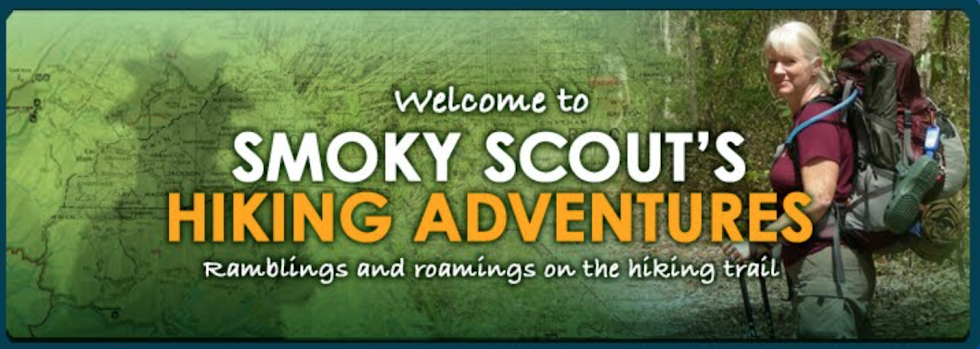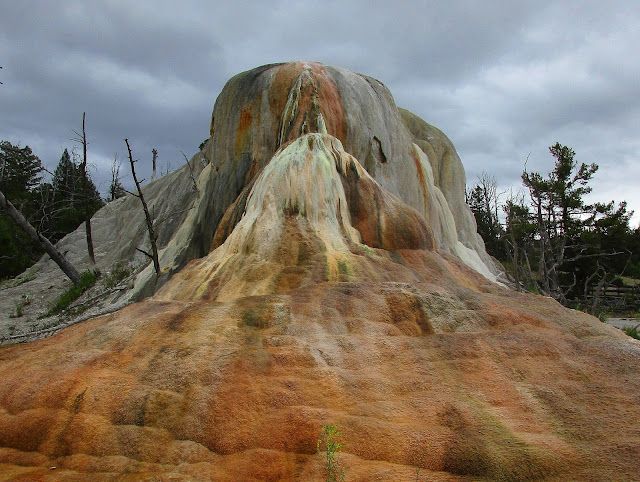Yellowstone National Park - 7/27/15 – Fairy Falls/Grand
Prismatic Spring/Mammoth Hot Springs – 6 Miles
This morning we broke down our campsite for the last
time. Back in January when we made our
Yellowstone plans, we figured that after five nights in a tent we would be
ready for cushier accommodations, and we wanted to experience one of the Park’s
historic lodges. Inspired advance
planning.
We’d covered a lot of ground in the previous five days and
this afternoon we had our eyes set on hiking Bunsen Peak near the north
entrance. This morning was our last
chance to enjoy the lower Grand Loop.
Looks like Fairy Falls is a good little walk.
After a little confusion with the instructions in Hiking
Yellowstone (for those of you who care, I think the description narrative
incorrectly says Fountain Flats Drive instead of Fountain Freight Road), Jim
and I began at the trailhead off of the lower Grand Loop just south of Grand
Prismatic Spring. After crossing the
Firehole River on a bridge, we walked for one mile on the wide flat gravel road
bed. We saw a couple of keep-off signs
on the mountainside on the left, alongside some obvious trails and even more obvious
people scrambling on those trails. Make
a note.
Fireweed
Butter-and-egg
The Fairy Falls Trail was totally flat, passing through
lodgepole pine remnants of a devastating 1988 fire…
…and new growth regenerating. We took a side detour to check out
backcountry campsite OD1.
Fairy Falls, 197 feet tall, has carved its niche in the
rock.
A closer look at Fairy Falls
On the walk back out, the multitudes were catching up to
us. We scaled the hillside we had noted
earlier, suspecting that it gave a bird’s-eye view of Grand Prismatic Spring,
part of the Midway Geyser Basin. The
scramble was surprisingly difficult, multiple eroded paths steeper than any trail
builder would create, but nevertheless people in flip-flops were making their
way up. I was most concerned that what
goes up must come down, and we ended up descending by a different route away
from the crowd. I wonder why the Park
doesn’t create a structure to accommodate the hundreds of people who take the
risk to see the GPS from that vantage point.
Because you’ve got to admit, it’s a sight worth seeing. The
colors are real. (Read about the science behind Grand Prismatic Spring here.) Click on the photo to see full screen. WOW.
We backtracked to our car and headed north, stopping in
Norris to visit the Museum of the National Park Ranger, a small but fascinating
exhibit. Did you know that Gerald Ford was a seasonal park ranger in Yellowstone in 1936? One of his assignments was as an armed guard
on the bear-feeding truck.
I enjoyed a long chat with the young seasonal ranger on
duty, asked him if he goes backpacking in the Park (he does). I mentioned that I had seen a hiker carrying
a firearm. The ranger had a lot to say
on the subject, primarily that the Park puts forth a great effort to educate
about bear activity and the use of bear spray.
Even though firearms are legal, if a person shoots a bear in
self-defense, he/she will still be fined because he/she had been advised to
use bear spray to deter rather than wound or kill the animal. The ranger doesn’t carry a firearm for those
reasons and because they are too heavy to be practical. And to quote the
ranger: “A gun is not going to stop 800
pounds of pissed off running at you anyway.”
When visitors ask him about the subject, he engages them to find out
what their safety concerns really are and encourages them to carry bear
spray.
Continuing north on the Grand Loop, we lost some time caught
in major road construction. Meanwhile,
the winds picked up and the clouds rolled in.
We realized that hiking above tree line to Bunsen Peak wasn’t going to
work out, and once again we shifted focus, this time to the thermal features at
Mammoth Hot Springs.
We walked the 2-mile Upper Terraces Road and took lots of pictures that fail to convey the other-world strangeness of the mineral formations
Butter-and-egg blooms in the millions
White Elephant Back Terrace
Orange Spring Mound
New Highland Terrace
We walked a little bit of the Lower Terraces area, a series of boardwalks with more features
that defy description
The rain set in and the temperature dropped. We were delighted to check into the Mammoth
Hot Springs Hotel, luxuriate in a hot shower and have a very short lie-down on
the comfy queen-size bed before moseying over to dinner at the Dining Room. At the bar we got into a conversation with
three college age guys who were working on a ranch for the summer. Where did they go to school? University of South Carolina. Small world.
Rained all night.
“Nature never hurries. Atom by atom, little by little she
achieves her work.” ~Ralph Waldo Emerson























































